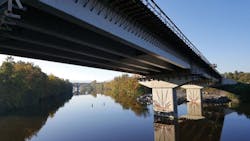No. 4 - American Parkway Lehigh River Bridge
Usually when you hit a pinnacle it’s a milestone. For lead designer Gannett Fleming and prime contractor New Enterprise Stone & Lime Co. Inc., dealing with a whole group of them was quite the event.
A layer of dolomite bedrock, known as the Allentown Formation, is the underbelly of the Lehigh River and created one of the biggest challenges on the American Parkway Lehigh River Bridge project.
“This formation of bedrock has pinnacles in it,” Scott Rhine, national design-build leader and transportation director at Gannett Fleming, told Roads & Bridges, “so we looked at doing spread footings in the river and we thought that would work.”
The spread footing approach was a success for Pier 3, but the pinnacles became thorny during construction of Piers 1 and 2. When crews attempted to drive sheeting so they could pump water out of the spread footing, the sheeting kept on getting caught up on the pinnacles of the bedrock.
“So it was not getting driven all the way down flush, so water kept seeping in and we could not get it dewatered,” said Rhine.
Design-build projects are made to handle twists like this. Piers 1 and 2 were redesigned for three 5-ft-diam. drilled shafts that were 34.5 ft long for Pier 1 and 39 ft long for Pier 2.
The project, however, did not offer flexibility everywhere. The river, railroad, surrounding community and roads created an extremely tight working environment, and the permitting was already set in stone when the lead designer and prime contractor came into play. Both saw that crane configuration was going to be cumbersome, and developed an erection scheme to cancel out the complexity. The issue came to play with Span 2 since the causeway did not extend far enough to use two cranes and set the 141-ft-long, 8-ft-deep concrete beams in place. So crews built the four other spans first and used a skid beam set to construct Span 2. Two cranes picked up beams from the causeway between Abutment 1 and Pier 1 and set them on the skid beam. The beams were then skidded out to a distance where a 500-ton crane, sitting on Span 3, could assist one of the cranes on the causeway to set the beams—five per span—in place.
Storm-water runoff was not allowed to run directly into the river, so a 10-in.-diam. fiberglass pipe runs the entire 1,300 ft length of the bridge. Thirty-two scuppers were used to accomplish the feat. There was a 50-ft distance from the last scupper to the first inlet at the Abutment 1 approach, so Gannett Fleming proposed installing two scuppers in the 30-ft approach slab and modified the scuppers that were detailed on the bridge to be used with a junction box. R&B
PROJECT: American Parkway Lehigh River Bridge
LOCATION: Allentown, Pa.
OWNER: City of Allentown
DESIGNER: Gannett Fleming
CONTRACTOR: New Enterprise Stone & Lime Co. Inc.
COST: $7.2 million
LENGTH: 705 ft
COMPLETION DATE: Late 2016
